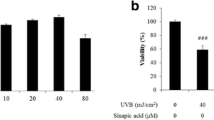Abstract
UV-induced DNA damage plays a key role in the etiology of certain diseases. The ability of blueberry anthocyanins and anthocyanidins (BA) to protect cellular DNA from UV-induced damage was investigated. BA were extracted by water (BAW), ethanol (BAE) or methanol (BAM). These extracts partially restored proliferation of UV-irradiated HepG2 cells as shown by MTT assay. Treatment with BA extracts at 75 μg/ml decreased reactive oxygen species and decreased DNA damage by tail moment of comet assay and expression of γH2AX in situ. BAM significantly decreased gene and protein expression of p53, phospho-p53 (Ser15), and p21 in UV-irradiated HepG2 cells. BA thus efficiently protects cells from DNA damage in vitro. Blueberry may potentially be used as a good source of naturally radioprotective agents.






Similar content being viewed by others
References
Adams LS, Kanaya N, Phung S, Liu Z, Chen S (2001) Whole blueberry powder modulates the growth and metastasis of MDA-MB-231 triple negative breast tumors in nude mice. J Nutr 141:1805–1812
Adams SL, Phung S, Yee N, Seeram NP, Li L (2010) Blueberry phytochemicals inhibit growth and metastatic potential of MDA-MB-231 breast cancer cells through modulation of the phosphatidylinositol 3-Kinase pathway. Cancer Res 70:3594–3605
Bae J, Lim S, Kim S, Choi J, Park J et al (2009) Bog blueberry anthocyanins alleviate photoaging in ultraviolet-B irradiation-induced human dermal fibroblasts. Mol Nutr Food Res 53:726–738
Ding H, Duan W, Zhu WG, Ju R, Srinivasan K, Otterson GA, Villalona-Calero MA (2003) p21 response to DNA damage induced by genistein and etoposide in human lung cancer cells. Biochem Biophys Res Commun 305:950–956
Jiang Y (2010) Extraction and determination of anthocyanins from Morus nigra L. growing in Xinjiang. Food Sci 14:93–96
Johnson RA, Ince TA, Scotto KW (2001) Transcriptional repression by p53 through direct binding to a novel DNA element. J Biol Chem 276:27716–27720
Kim SH, Hur YJ, Lee SJ et al (2011) E6 and E7 fusion immunoglobulin from human papilloma virus 16 induces dendritic cell maturation and antigen specific activation of T helper 1 response. Biotechnol Lett 33:663–671
Kinner A, Wu W, Staudt C, Iliakis G (2008) γ-H2AX in recognition and signaling of DNA double-strand breaks in the context of chromatin. Nucleic Acids Res 36:5678–5694
Liu W, Wang H, Wang LK, Su LL, Luo C (2011) COX-2 and Nrf2/ARE signaling pathways in anti-inflammation and antioxidation in vivo and in vitro. Chin Bull Life Sci 10:1027–1033
Luo C, Urgard E, Vooder T, Metspalu A (2011) The role of COX-2 and Nrf2/ARE in anti-inflammation and antioxidative stress: aging and anti-aging. Med Hypotheses 77:174–178
Matsuo M, Sasaki N, Saga K, Kaneko T (2005) Cytotoxicity of flavonoids toward cultured normal human cells. Biol Pharm Bull 28:253–259
Mozaffarieh M, Schoetzau A, Sauter M, Grieshaber M, Orgul S (2008) Comet assay analysis of single-stranded DNA breaks in circulating leukocytes of glaucoma patients. Mol Vis 14:1584–1588
Oh KS, Bustin M, Mazur SJ, Appella E, Kraemer KH (2011) UV-induced histone H2AX phosphorylation and DNA damage related proteins accumulate and persist in nucleotide excision repair-deficient XP-B cells. DNA Repair 10:5–15
Tang XQ, Feng JQ, Chen J, Chen PX, Zhi JL, Cui Y, Guo RX, Yu HM (2005) Protection of oxidative preconditioning against apoptosis induced by H2O2 in PC12 cells: mechanisms via MMP, ROS, and Bcl-2. Brain Res 1057:57–64
Tzeng S, Huang H (2003) Downregulation of inducible nitric oxide synthetase by neurotrophin-3 in microglia. J Cell Biochem 90:227–233
Zhou X, Jia J (2010) P53-mediated G (1)/S checkpoint dysfunction in lymphocytes from Alzheimer’s disease patients. Neurosci Lett 3:320–325
Acknowledgments
This project was supported by an initial fund from Tianjin city government for “1000 talents plan” program to C. L. Authors are thankful to Dr. Lei Zhang, Hualida Co. Tianjin, China for his critical comments for preparation of the manuscripts.
Conflict of interest
The authors declare no conflicts of interest.
Author information
Authors and Affiliations
Corresponding author
Electronic supplementary material
Below is the link to the electronic supplementary material.
Rights and permissions
About this article
Cite this article
Liu, W., Lu, X., He, G. et al. Cytosolic protection against ultraviolet induced DNA damage by blueberry anthocyanins and anthocyanidins in hepatocarcinoma HepG2 cells. Biotechnol Lett 35, 491–498 (2013). https://doi.org/10.1007/s10529-012-1105-2
Received:
Accepted:
Published:
Issue Date:
DOI: https://doi.org/10.1007/s10529-012-1105-2




